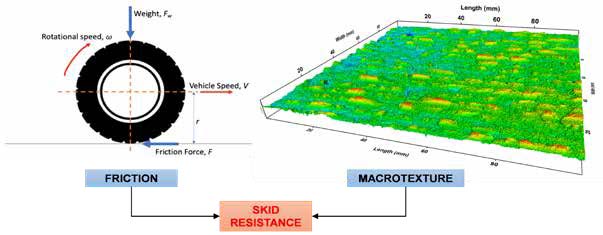Skid resistance is a critical factor affecting highway safety during wet conditions such as rain, snow or flooding. When skid resistance is higher, a braking vehicle can stop in a shorter distance, and the chances of a collision may be reduced. Wet conditions reduce the skid resistance because the water can lubricate the driving surface and also affect the overall interactive forces between the tire and pavement surface. This lubricating effect is dependent on many factors including the surface’s micro- and macro-texture, surface texture connectivity, tire characteristics and speed.
Shane Underwood, professor; Cassie Castorena, professor; and Boris Goenaga, postdoctoral scholar, along with Paul Rogers, Ph.D. student and project manager at KPR Engineering PLLC, conducted research for the North Carolina Department of Transportation (NCDOT) to better understand the effects of friction and texture on safe driving.
“The NCDOT was interested in doing this project because it wanted to get a better handle on pavement skid resistance behaviors,” Underwood said. “The NCDOT has a really difficult job in managing the annual Highway Safety Improvement Program. This program, among other things, addresses crashes occurring when cars leave their lanes. Understanding the effects of friction and macro-texture is important to mitigating these kinds of crashes.”

The team measured friction and texture features at 153 sites in North Carolina. Asphalt samples were collected in the field and studied in the lab for a subset of these sites. The researchers developed models to understand how friction and texture change with time and proposed threshold limits for friction and texture that could help prevent wet lane departure collisions and increase safety.
The models help the NCDOT understand and predict how texture and friction can change on its pavements over time. The researchers found the same rate of deterioration for friction was applicable across roads of different classifications such as interstates and state highways across several regions. They found that for texture, different rates must be considered: Faster deterioration was observed in some regions of the state relative to others.
The team also did a cost-benefit analysis to evaluate the viability of widespread adoption of mitigation strategies such as adding surfaces with greater texture or better water drainage or shotblasting the existing surface to increase texture. Their analysis showed that such strategies could be potentially viable, but that further analysis relating to the complexities of such policy decisions is warranted. The team is currently performing a follow-up study to evaluate new pavement surfacing options with respect to safety and long-term performance implications.
This research was published in a paper titled “Using Continuous Traffic Counts Extracted from Smartphone Data to Evaluate Traffic Reductions During COVID-19 Pandemic in North Carolina” in Latin American Transport Studies, and in a paper titled “Early Friction and Texture Evolution after an Asphalt Overlay” in Transportation Research Record: Journal of the Transportation Research Board. The research was also presented at various national venues including the Annual Meeting of the Transportation Research Board, The Road Users and Profilers group, and various state venues.
